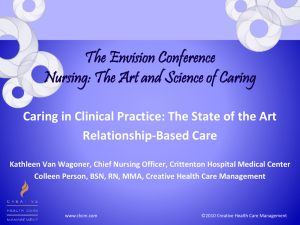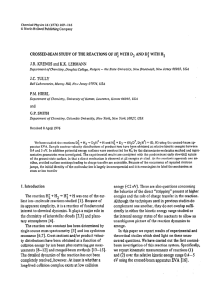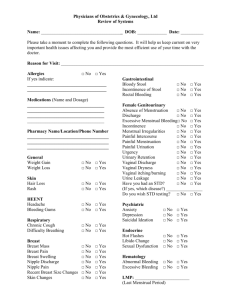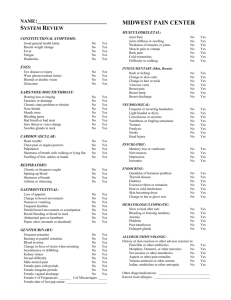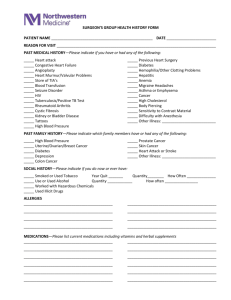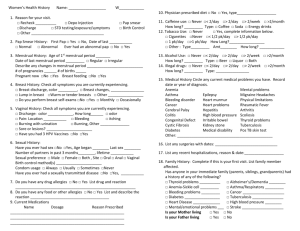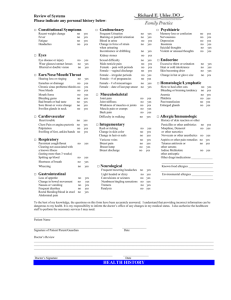bcdonebutton2 Class Completed!
advertisement
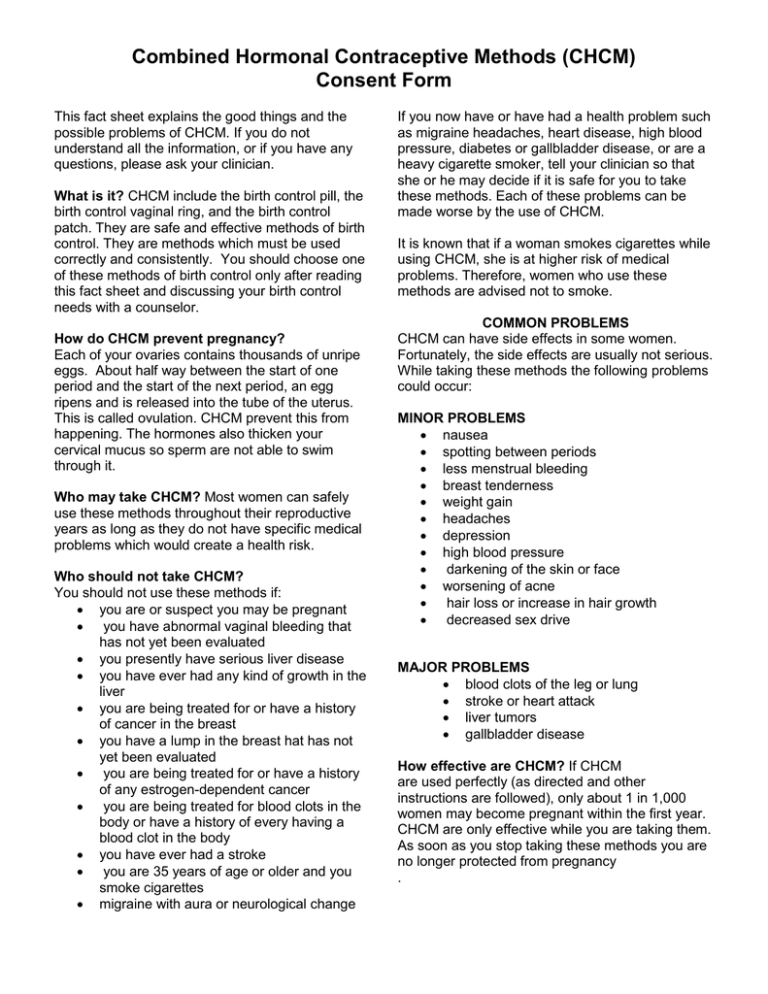
Combined Hormonal Contraceptive Methods (CHCM) Consent Form This fact sheet explains the good things and the possible problems of CHCM. If you do not understand all the information, or if you have any questions, please ask your clinician. What is it? CHCM include the birth control pill, the birth control vaginal ring, and the birth control patch. They are safe and effective methods of birth control. They are methods which must be used correctly and consistently. You should choose one of these methods of birth control only after reading this fact sheet and discussing your birth control needs with a counselor. How do CHCM prevent pregnancy? Each of your ovaries contains thousands of unripe eggs. About half way between the start of one period and the start of the next period, an egg ripens and is released into the tube of the uterus. This is called ovulation. CHCM prevent this from happening. The hormones also thicken your cervical mucus so sperm are not able to swim through it. Who may take CHCM? Most women can safely use these methods throughout their reproductive years as long as they do not have specific medical problems which would create a health risk. Who should not take CHCM? You should not use these methods if: you are or suspect you may be pregnant you have abnormal vaginal bleeding that has not yet been evaluated you presently have serious liver disease you have ever had any kind of growth in the liver you are being treated for or have a history of cancer in the breast you have a lump in the breast hat has not yet been evaluated you are being treated for or have a history of any estrogen-dependent cancer you are being treated for blood clots in the body or have a history of every having a blood clot in the body you have ever had a stroke you are 35 years of age or older and you smoke cigarettes migraine with aura or neurological change If you now have or have had a health problem such as migraine headaches, heart disease, high blood pressure, diabetes or gallbladder disease, or are a heavy cigarette smoker, tell your clinician so that she or he may decide if it is safe for you to take these methods. Each of these problems can be made worse by the use of CHCM. It is known that if a woman smokes cigarettes while using CHCM, she is at higher risk of medical problems. Therefore, women who use these methods are advised not to smoke. COMMON PROBLEMS CHCM can have side effects in some women. Fortunately, the side effects are usually not serious. While taking these methods the following problems could occur: MINOR PROBLEMS nausea spotting between periods less menstrual bleeding breast tenderness weight gain headaches depression high blood pressure darkening of the skin or face worsening of acne hair loss or increase in hair growth decreased sex drive MAJOR PROBLEMS blood clots of the leg or lung stroke or heart attack liver tumors gallbladder disease How effective are CHCM? If CHCM are used perfectly (as directed and other instructions are followed), only about 1 in 1,000 women may become pregnant within the first year. CHCM are only effective while you are taking them. As soon as you stop taking these methods you are no longer protected from pregnancy . BENEFITS Many women experience the following benefits from using these methods: decreased menstrual cramps decreased menstrual bleeding more regular menstrual bleeding decreased pain at the time of ovulation improvement in acne less risk of developing ovarian and/or endometrial cancer less risk of developing benign breast tumor and/or ovarian cysts some women note a reduction in PMS REPORT ANY NEW OR UNUSUAL MEDICAL PROBLEMS TO YOUR CLINICIAN RIGHT AWAY Other medical drawbacks and risks: Between 1% and 2% of women will not menstruate for6 months or more after stopping CHCM. If you do not have your period, return to the clinic for a pregnancy test. If your periods are irregular prior to taking pills, they may again become irregular after you stop these methods. The estrogen hormone in these methods slightly decreases the quality and quantity of breast milk. Some experts advise against CHCM while breast feeding if other options are available. Lack of protection against STDs. While CHCM are a highly-effective, convenient methods of birth control, they do not provide any protection against sexually transmitted infections such as gonorrhea, chlamydia, or HIV (the virus that causes AIDS). If you or any of your sexual partners have other partners, it is very important to use a latex condom every time you have sex in order to protect yourself against these infections. PRECAUTIONS YOU SHOULD TAKE Tell any health care provider that you see that you are using CHCM. When using these methods, you should call your clinic right away if you have any of the following: numbness or severe headaches which are not tension headaches and are not relieved with aspirin severe leg pain (calf or thigh; usually one leg) severe chest pains, shortness of breath eye problems; blurred vision, flashing lights, or blindness severe abdominal pain Please read each of the listed items below and place a check in the box provided that applies to you. I have been directed to the Fronske web site: http://www.nau.edu/birthcontrol for comprehensive birth control information. I have read the above statement about Combined Hormonal Contraceptive Methods and have had the opportunity to ask questions. I understand the risks and benefits of CHCM and wish to receive a CHCM. Complete the spaces below. Date Student ID Number__________________________ Name______________________________________________________________________________ (please print) Signature Witness Informedconsent.doc 4/06
